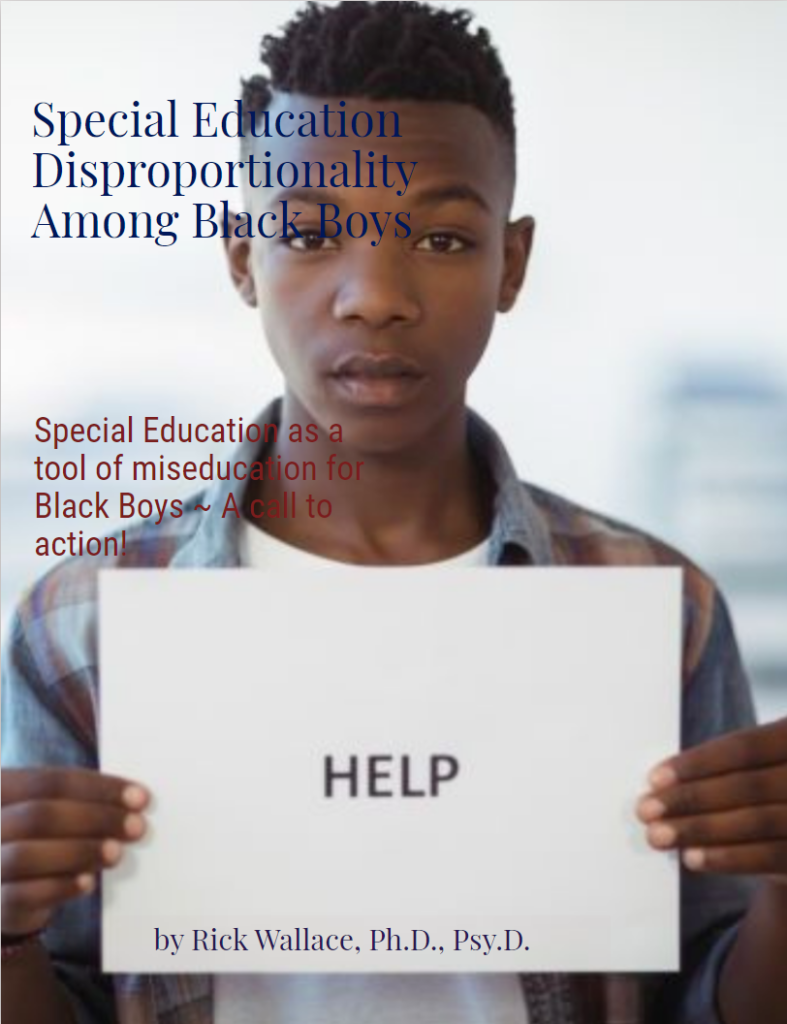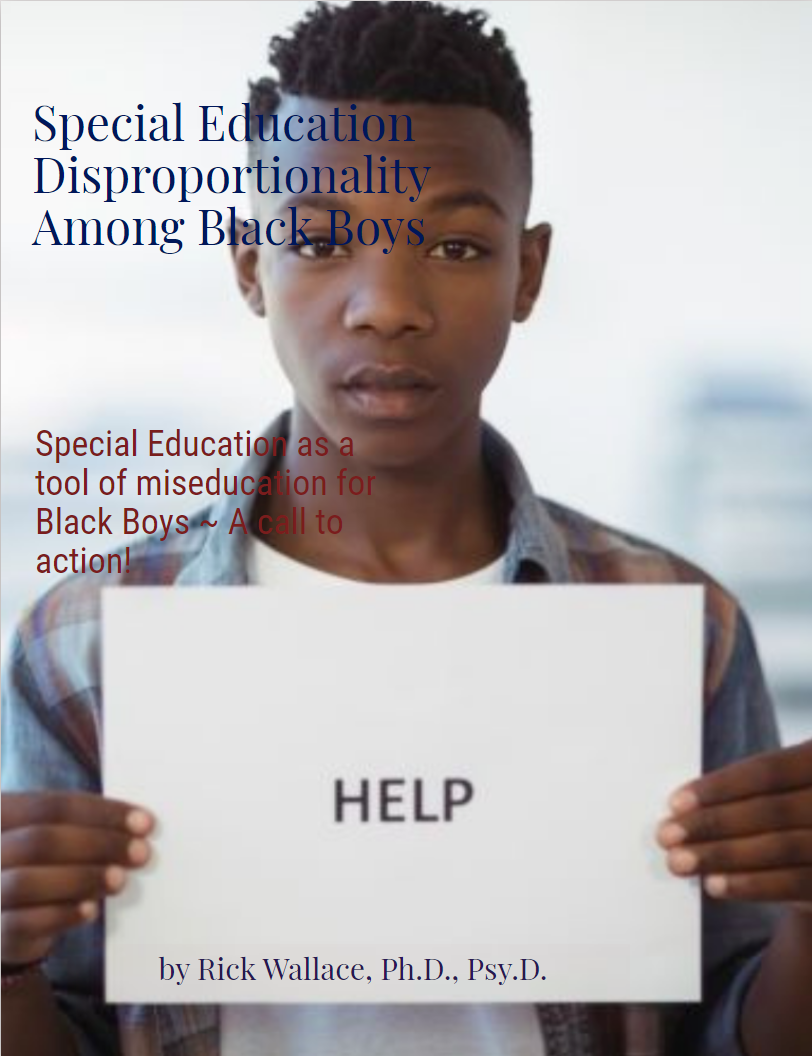Confronting Special Education Disproportionality Among Black Boys! For more than four decades, it has been evident that African American youth have been significantly overrepresented in the special education system (Codrington & Fairchild, 2012; Blanchett, 2009; Gardner & Miranda, 2001).

In 1997, The United States Department of Education identified disproportionate minority representation of African American students in the special education system, with those more prevalently affected being African American males. This disproportionality was readily identified as a critical issue that needed to be addressed aggressively. From the fall of this discovery, which was long overdue, The Individuals with Disabilities Education Act (IDEA) of 1997 was passed.
To truly understand the pernicious nature of the special education system, it must be perceived within its proper context. When the U.S. Supreme Court ruled that segregation in education, based on any characteristic differences, including race, was unconstitutional, those who advocate institutional and structural racism had to create an alternative modality for continuing to separate black students from white students. Their solution was the creation of a special education program that could identify blacks as having learning disabilities that required them to be in separate classrooms (Johnson, 2013).
The statistics that reflect this dilemma are quite alarming. For instance, although African American students only make up 16 percent of the public education population, they constitute more than 21 percent of the students that have been diagnosed as special needs students through special education criteria. When socioeconomic variables are factored into the equation, the numbers are even more disparaging, where African American students, who qualify as living at the poverty line, are 2.3 times more likely to be identified by their teacher as suffering from mental retardation than are their white counterparts.
To further exacerbate this enigmatic issue, the IDEA discovered that some minority groups (primarily African American males) were more likely to be misdiagnosed and misplaced into special education programs than white students. In response to its findings, the IDEA implemented measures through regulations that governed federal, state and local educational agencies as far as minimizes the overrepresentation of African Americans in the special education system. However, despite the efforts of the IDEA, the overrepresentation of African American students, especially African American males, continues. In fact, it is getting worse in a number of critical areas.
It is important to note that while certain entities have gone to great lengths to present a narrative that suggests that African Americans are intellectually inferior, there is no empirical evidence to support any such postulation (Johnson, 2013). In fact, when afforded with equal footing and resources, African American students, including African American males, have excelled as a collective group.
Based on recent empirical data, African American students between the ages of 6-21 are 2.86 times more likely to be placed in some form of special education program under IDEA guidelines that define mental retardation. Additionally, this same group is 2.28 times more likely to be diagnosed as being in need of special services due to emotional disturbance than other students within the same age, but from different ethnic and racial groups combined.
This paper is reflective of the review of available literature on this topic. Following is a statement of the problem that provides elucidation of the issue of overrepresentation of African Americans in special education. This paper addresses culpability in its totality, including the roles of teachers, parents, institutional & structured racism, societal factors, student attitudes and behavior, etc. — offering a number of propositional quaesitums to the current disproportionality in special education.
Over the past 20 years, Dr. Wallace has invested more than 45,000 hours of research into understanding the scientific implications of white supremacy and how they have directly impacted African Americans in all nine areas of human activity, which include economics, education, entertainment, labor, law, politics, religion, sex and war. He has spent a substantial amount of time attempting to answer the question of why blacks seem incapable of overcoming the barrier of racism despite the fact that the solution has been placed before them.
The preponderance of the evidence that Dr. Wallace has examined has provided him with a lucid perspicacity of the complex dynamic at play — a dynamic that includes psychological, sociological, economic and political oppression that is executed through multitudinous pernicious machinations. He has used this information to develop what he calls The Black Community Empowerment Blueprint 1.0. This blueprint is a comprehensive strategy that addresses every area of concern for the black collective in great detail. Dr. Wallace has also disseminated his findings in a number of literary works, including his latest book, The Mis-education of Black Youth in America.
Currently, Dr. Wallace is moving into the second phase of his research, transitioning from inductive research to deductive research for the purpose of advancing and introducing certain scientific theories associated with the African American experience. To this date, Dr. Wallace’s research has proven to be immensely valuable, as he develops social programs to counter external influences, lectures to African Americans across the nation and develops a comprehensive blueprint capable of facilitating the complete elevation and empowerment of African Americans, as well as the complete diaspora in time, but the cost of research can be quite exorbitant, especially when he is investing between 55-85 hours per week.
To this point, all funding has been covered by Dr. Wallace himself. He is currently seeking research funding, but due to the specific focus of his research, traditional channels, such as government, academic and private grants are not an option. While he currently has a couple interested sponsors, both of them are non-blacks, which speaks volumes. While Dr. Wallace has committed to proceeding at all cost, the support of the community and people he is fighting for will prove highly beneficial in multitudinous ways.
Special Education Disproportionality Among Black Boys
Get Your Digital Copy Here & Support the Research at The Odyssey Project!
Support the work of The Odyssey Project and its community programs, including our Research Department, the Black Men Lead rite of passage program for young Black males, Restoring Ghettos Forgotten Daughters, Music is Life, Financial Literacy 101 & Beyond, and more at https://checkout.square.site/pay/6bd43633069e41b5baae87299a884aa9 or https://www.theodysseyproject21.top/donate or you can contribute directly through the Cash app at $TheOdysseyProject21


![IMG_1034[1]](http://www.theodysseyproject21.com/wp-content/uploads/2015/01/IMG_10341-300x300.jpg)